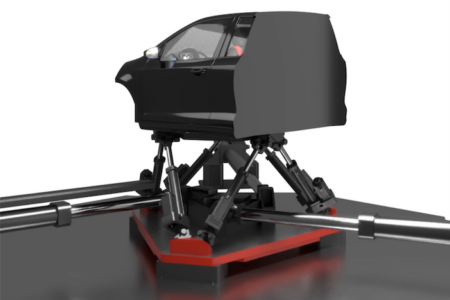A next-generation vehicle driving simulator has been developed by AB Dynamics, which is intended to reduce development times and costs. According to the company, the ‘advanced Vehicle Driving Simulator’ (aVDS) offers reduced latency and increased frequency response compared to alternative systems, which allows more test, development and calibration tasks to be completed without a prototype vehicle.
“With a proliferation of new models and new technologies, pressure on time and budgets continues to grow. Vehicle dynamics simulators help to address these challenges by providing engineers with the physical experience of driving a vehicle but in the repeatable environment of a laboratory,” stated Dr Adrian Simms, business manager for laboratory test systems at AB Dynamics.
“Until now, the range of applications has been constrained by the physics of the motion platform, which has generally limited simulator use to human machine interface and ergonomic studies. The high performance required for vehicle dynamics applications has not been available,” added Simms.
“Our new approach advances performance to a degree that allows much more to be achieved, extending the range of applications into many other functions that would traditionally have required a prototype vehicle,” continued Simms. “We believe that this is the first system to offer a high-resolution, fully-representative driving experience, making it the first true vehicle driving simulator.”
How the technology works
The simulator uses a motion platform and motion control techniques designed by Williams in its Formula 1 operations, with immersive digital content provided by software supplier, rFpro.
According to AB Dynamics, by providing precise on-time cueing (audio, visual, haptic and vestibular), the aVDS immerses the driver in the experience, creating the impression of driving. A high excursion capability ensures plenty of travel for effective motion cueing, enhancing the impression of changes in speed and direction. Low latency ensures that all the driver’s senses are cued at precisely the right time. As well as increasing the realistic feel of the drive, this also helps to eliminate motion sickness that can be felt in some systems.
The company adds that the unique arrangement of the motion platform means that consistently high frequency response is achieved throughout the full range of travel. This ensures accurate simulation of vehicle attributes, including ride quality and steering feel, wherever the moving platform goes.
According to AB Dynamics, there are problems with rival systems. For example, where a hexapod architecture is used, impressive travel in one axis can hide limited excursion in combined directions. Systems with additional mechanisms to overcome this inherent limitation will have higher mass and inertia, which is detrimental to the simulator’s performance.
The AB Dynamics system solves these problems by mounting a vehicle cockpit on four identical ‘wedge’ actuator modules mounted on two parallel rails. Quiet and lightweight linear motors control both the height of the platform on the wedge and the position of the wedge on the rail. The platform is cleverly designed with angled sides. It is moved backwards and forwards by changing the distance between the wedges on each rail. Turning the platform is achieved by moving the front and rear actuator pairs in opposite directions along the rails. Heave, pitch and roll are controlled by moving the wedges independently to lift or lower the platform at each corner.
A large radius screen wraps around the installation to provide an immersive driving environment. Software from rFpro provides high definition graphics and audio, including high frequency input to replicate measured road textures. A library of rFpro proving ground and public road models already exists and can be supplemented with bespoke LIDAR scans of test routes. The rFpro software wraps around all the mainstream vehicle modelling tools and integrates programmable traffic modules, including additional robot or human drivers occupying the same environment, making it ideal for the development of ADAS.
The high payload capability allows a full vehicle front-end and cockpit module to be mounted on the motion platform, or alternatively a carbon composite cockpit can be specified.
AB Dynamics’ CTO, Dr Stephen Neads, stated the aVDS is the first step in a vision that will bridge the gap between objective and subjective testing, and which provides a link between computer-based simulation, laboratory-based simulation and whole vehicle testing both in the laboratory and on the test track. “The aVDS works very effectively as a stand-alone product, but can also be the central tool in a suite of test and development systems that increase correlation, reduce timescales and simplify development programs.”




